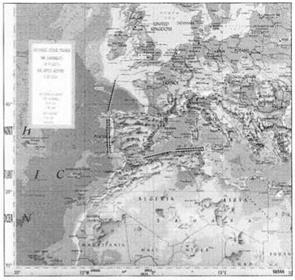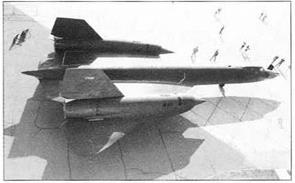Cuba
Early in the Senior Crown Programme, Cuban reconnaissance sorties became a task for the 9th SRW. Flown from Beale and initially code-named Giant Plate, the designation was later changed to ‘Clipper’. Most sorties were ‘stand-ofF runs, flown abeam the island in international airspace. Such a mission would typically take three and a half hours to complete and was considered very routine. Occasionally however, the track was modified to take the aircraft directly over Cuba. W hen the Carter administration entered office, they suspended all overflight actively in an act of ‘goodwill’. In 1978 however, a reconnaissance satellite photographed a Soviet freighter in Havana harbour surrounded by large crates that were being moved to a nearby air base where aircraft were being reassembled. It appeared that 15 MiG-23s had been supplied to Castro’s Air Force. The MiG-23BN Flogger H Model was known to be capable of carry ing nuclear weapons and if it was this variant that had been exported, then the shipment violated the 1962 Soviet pledge not to deploy ‘offensive’ weapons on Cuba. Two sorties were flown by SR-71s over Cuba in November 1978. These verified that
|
|
Above Map used by Secretary of Defence Casper Weinberger at a White House briefing shows route details of Operation Eldorado Canyon, the US strike at Libya on 15 April 1986.
(DoD)
Below Lt Cols Jerry Glasser and RSO Ron Tabor return 17980, callsign Tromp 30, back to Mildenhall following the successful completion of their Bomb Damage Assessment (BDA) flight.
(Paul Crickmore Collection)
Opposite above After the raid, some degraded shots were released to the press. Although never officially acknowledged, they originated from the SR-71’s camera system. (DoD)
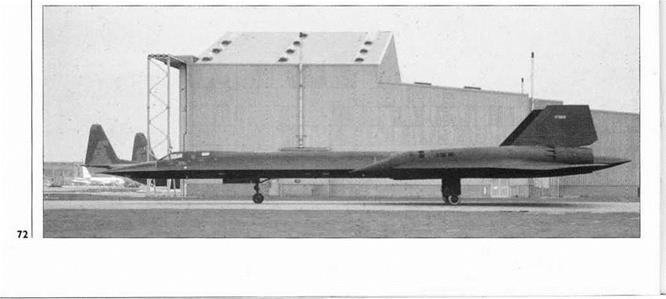
Opposite, bottom Just before 17980 returned to the US on completion of its TDY stint at Det 4, three dark red camel emblems were applied to the left nose gear door, in recognition of its part in the Eldorado Canyon sorties. (Paul Crickmore )
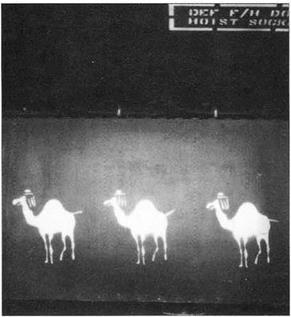
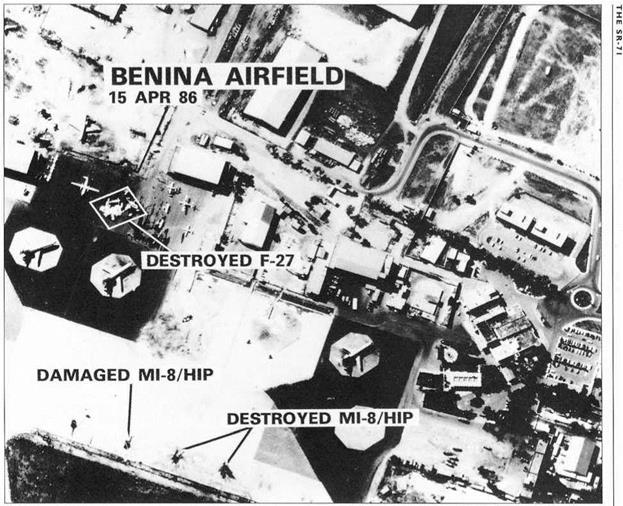 |
they were in fact MiG-23Ms Flogger Es, optimised for air defence; evidence which substantiated Soviet claims.
Det 4, Mildenhall
Not long into Senior Crown, the total number of opera – tial SR-71s was scaled down. The two flying squadrons became one in April 1971. Then as the US disengaged itself from Vietnam, the number of unit-authorised aircraft also declined. By 1977, the number of SR-71A Primary Authorised Aircraft (PAA) stood at six and funding was reduced proportionately. Despite being tasked by national agencies to support a variety of theatre intelligence requirements, this extremely expensive aircraft operation was funded by the Air Force. HQ^ SAC were hostile to Senior Crown because it diverted funds away from its bomber and tanker mission and national intelligence agencies had become enamoured with satellite generated products. SAC’s Single Integrated Operational Plan (SIOP), for the unthinkable needed SIG1NT to keep it up to date, and the SR-71 wasn’t capable of gathering ‘long-on-station’ samples of SIGINT like the RC-135s and U-2Rs. The loss of its SAC patronage left Senior Crown increasingly isolated and vulnerable. To survive
![]()
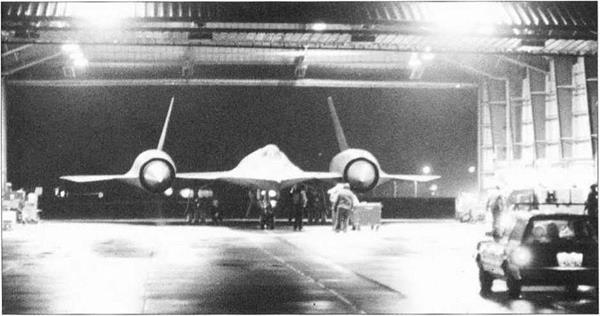
continued budgetary raids, it was apparent that the SR – 71’s utility had to be improved in order to become competitive with overhead systems. This required an updated sensor package, particularly an air-to-ground data link system coupled to its Synthetic Aperture Radar.
A ‘marketing package’ was assembled which included details of the SR-71’s performance and imagery capabilities. In the mid-seventies, Senior Crown advocates embarked on a PR campaign within the Washington intelligence community to gather support for the program. Following a briefing to intelligence officers of the Navy’s Atlantic fleet, interest was expressed in the SR-71’s seascanning radar capabilities to detect submarines in their home ports in the Baltic and Arctic areas. The possibility existed that a new requirement could arise which would give Senior Crown a second lease of life. Two missions were flown over the Soviet Pacific fleet near Vladivostok to test the concept and the results were impressive.
Eighteen months after aircraft ‘972 had established a new transatlantic world speed record, the same aircraft returned to England and flew two aborted missions in a bid to obtain SLAR imagery of the Soviet Northern fleet. The ten-day deployment was an intelligence gathering failure, however important lessons were learned about aircraft operating procedures in Arctic air masses.
Aircraft ‘962 arrived during Exercise Teamwork on 6 September 1976, and flew’ the very next day on a ‘Barents Sea Mission’ codenamed Coldfire 001. Majs Rich Graham and Don Emmons flew that and another round – robin sortie out of RAF Mildenhall, Suffolk, before returning ‘962 to Beale on 18 September. The SR-71’s SLAR and camera systems ‘to gather simultaneous, synoptic coverage’ of the Soviet submarine fleet based on the Kolskiv Polustrov, in Murmansk and bases on the Baltic had been validated. After nearly two years of short TDY deployments, Detachment 4 (Det 4) of the 9th SRW was activated and two SR-71s were permanently based at RAF Mildenhall.
Above All battened down and ready for a mission, the crew of 17964 awaits signals from a ground marshal in December 1987.
(Paul Cnckmore)
Opposite, top 17962 formates with two RAF Jaguars of 41 Recce Squadron, based at RAF Coltishall. (Crown Copyright)
|
Below 17980 at the RAF Mildenhall Airshow. (Paul Cnckmore)
|











